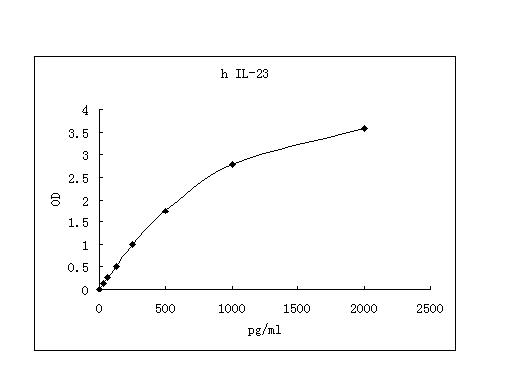Detect Range: 31.25-2000pg/ml
Sensitivity: 4pg/mL
Sample Type: Cell culture supernatant, serum, plasma (EDTA, citrate, heparin)
Sample Volume: 20 uL
Assay Time: 3 hours
Detection method: Colorimetric

Interleukin 23 (IL-23) is a heterodimeric cytokine that is related to IL-12 (1-3). It is composed of two disulfide-linked subunits, a p19 subunit that is unique to IL-23, and a p40 subunit that is shared with IL-12 (3-7). The p19 subunit has homology to the p35 subunit of IL-12, as well as to other single chain cytokines such as IL-6 and IL-11. The human p19 subunit cDNA encodes a 189 amino acid (aa) residue precursor protein with a putative 19 aa signal peptide and a 170 aa mature protein. Human and mouse p19 subunits share 70% aa sequence identity. The functional IL-23 receptor complex consists of two receptor subunits, the IL-12 receptor β1 subunit (IL-12 Rβ1) and the IL-23-specific receptor subunit (IL-23 R) (7). IL-23 is produced by dendritic cells and macrophages in response to pathogens including certain bacteria and viruses and/or their components (3). IL-23 and IL-12 have overlapping but distinct biological activities. The IL-23 immune pathway induces the earliest recruitment of neutrophils to the site of infection while the more classic host defense and cytotoxic response is stimulated by IL-12 (4). IL-12 drives the development of Th1 cells and induces production of IFN-γ by NK cells (3). In contrast, IL-23 has a role in the development/maintenance of a T cell subset characterized by the production of IL-17A, IL-17F, IL-6, and TNF-α (3, 4, 8). The induction of IL-17-producing T cells may involve the actions of TGF-β while their survival and expansion may be IL-23-dependent (9-11). The IL-23/IL-17 axis is an important mediator of inflammation. In mouse models, transgenic over-expression of IL-23 leads to a systemic inflammatory response (12). IL-23 effects on IL-17-producing T cells may also enhance the development of several models of autoimmune disease including experimental allergic encephalomyelitis (EAE), collagen-induced arthritis (CIA), colitis, and diabetes (5, 8, 13-17). IL-23 may also play a role in increased tumor growth associated with chronic inflammation (18). In humans, IL-23 has been found upregulated in several pathologies with dysregulated immune function including psoriasis, Crohn
Hunter, C.A. (2005) Nat. Rev. Immunol. 5:521.
Langrish, C.L. et al. (2004) Immunol. Rev. 202:96.
McKenzie, B.S. et al. (2006) Trends Immunol. 27:17.
Aggarwal, S. et al. (2003) J. Biol. Chem. 278:1910.
Cua, D.J. et al. (2003) Nature 421:744.
Oppmann, B. et al. (2000) Immunity 13:715.
Parham, C. et al. (2002) J. Immunol. 168:5699.
Langrish, C.L. et al. (2005) J. Exp. Med. 201:233.
Veldhoen, M. et al. (2006) Immunity 24:179.
Mangan, P.R. et al. (2006) Nature 441:231.
Bettelli, E. et al. (2006) Nature 441:235.
Wiekowski, M.T. et al. (2001) J. Immunol. 166:7563.
Nakae, S. et al. (2003) J. Immunol. 171:6173.
Nakae, S. et al. (2003) Proc. Natl. Acad. Sci. USA 100:5986.
Mensah-Brown, E.P. et al. (2006) Eur. J. Immunol. 36:216.
Yen, D. et al. (2006) J. Clin. Invest. 116:1310.
Chen, Y. et al. (2006) J. Clin. Invest. 116:1317.
Langowski, J.L. et al. (2006) Nature 442:461.
Piskin, G. et al. (2006) J. Immunol. 176:1908.
Fuss, I.J. et al. (2006) Inflamm. Bowel Dis. 12:9.
Vaknin-Dembinsky, A. et al. (2006) J. Immunol. 176:7768.
My Review
© 2017, AbSci All Rights Reserved. E-mail: info@abscitech.com
南京川博生物技术有限公司版权所有
苏B1-20150380 苏ICP备15009006号-1